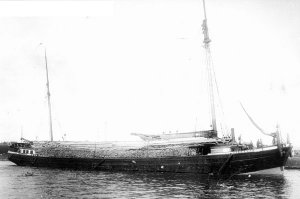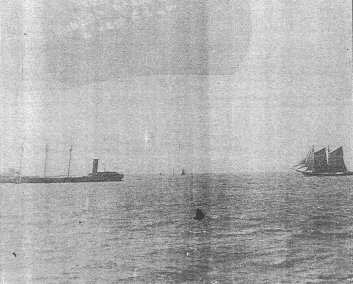
Type: Wooden Schooner Barge Length: 196.1 x 33.9 x 13.9 ft., 747 gt., 710 nt. Depth: 10 ft. Location: Rabbit Bay LAT/LON: 47.05.344/88.18.931
This Lizzie Law was built as a large three masted topsail schooner in 1875
at Port Huron, Michigan by J.H. Fitzgerald for Robert Law of Chicago. She was
built for the grain trade between Buffalo and Chicago, but was later used in
the coal and lumber trade on the Lakes. A large vessel, she could carry 1,000,000
ft. of lumber when fully loaded and had an overall length of 210 ft. when she
was still rigged for sail.. The Law was one of only two large schooners ever
built on the Lakes with leeboards (an stern centerboard that kept the vessel
straight in winds) and she also had the distinction of being the last schooner
ever to carry a grain cargo out of Chicago. During her sailing career she was
regarded as a fast and handsome schooner, making the round trip from Chicago
to Buffalo in 25 days.

The Law as she appeared in 1907
The Lizzie Law had a few scrapes during her career, which resulted in rebuilds. In 1882, the Law received a rebuild following an unknown accident, and in 1893, the Law's pumps failed and she sank in the Pelee Passage on Lake Erie. Completely submerged in about 30 ft. of water, she remained on the bottom for three months before she was pumped out and repaired. She again got into trouble off Grand Marais, Michigan on Lake Superior in 1903 when her pumps failed. She was waterlogged and sinking when the Grand Marias Lifesaving Station spotted her and came to her rescue. They took the exhausted crew off the vessel and towed her to safety where her pumps could be fixed. Around 1900, the Law was cut down to a schooner barge, having her center mast and bowsprit removed. After this change, she was sold to the Edward Hines Lumber Company of Chicago and was always towed by the steamer Edward L. Hines.

Lizzie Law Sunk at Pelee Passage - 1893
The Lizzie Law met her end on October 19, 1908 while upbound from Chicago to Duluth with a cargo of coal. She was in tow of the Edward L. Hines, which was also towing the schooner barge Selden E. Marvin. A serious gale was blowing when the trio reached the Huron Islands causing the Marvin and Law to break their towlines. The two vessels were carried in the trough of the waves toward the Keweenaw coast. The crew of the Hines had a difficult time relocating the vessels due to smoke from forest fires that covered the Lake.
Within a few hours, both the Marvin and the Law had grounded hard on Traverse Island on the south side of the Keweenaw Peninsula. The crew of the Law were in peril, as large waves were sweeping over the decks of the vessel. At length, one of the crew volunteered to try rowing the yawl the few hundred yards to shore with a line, but his boat was capsized, throwing him into the boiling surf. With great exertions, he managed to swim to shore an affix the line to a tree, thereby allowing the other 7 men and 1 woman to get ashore.
The next day, the Hines located the two vessels. The Marvin was scuttled to the bottom to prevent her from pounding to pieces, but the Law was already badly damaged. In the following months, the Marvin was recovered, but salvors struggled to save the Law. The cold, rough Keweenaw winter was closing in quickly and salvors stripped the Law of all her rigging and hardware. By the next spring, she was a total loss. Local Keweenaw residents crossed the ice to the wreck and salvaged a good deal of wood and hardware as well. Pieces of the Lizzie Law still adorn the barn of at least one local resident.
Local divers located the fragmentary remains of Lizzie Law in the 1980s, but several mysteries remain concerning this wreck. The Law's remains lie well offshore in Rabbit Bay, on the Keweenaw mainland, but most accounts state that the Law was wrecked on Traverse Island. How did her remains get to the mainland? Further, the remains that exist are extremely fragmentary, consisting of a few sections of keelson and ribs. Where is the rest of the wreck? Divers have reported that larger sections of the wreck exist. Perhaps part of the wreck drifted ashore, leaving the main section somewhere closer to the Island. It is equally possible that the vessels actually wrecked on the mainland, as original news reports do not specifically state that she was on the Island.
The remains of the Law lie well offshore in Rabbit Bay and consist of two small sections of keelson and ribbing, one 53 ft. long, the other 40 ft. long. The most interesting thing about this site is the "fossil imprint" the remains have left in the red sandstone lake bed. Nearly 100 years of pack ice have ground the remains into the soft stone, leaving a distinct impression of the members in the rock. The site is only accessible by boat and is difficult to find. The best way to locate it is to watch the lake bottom for the dark outline of the remains. This site is very exposed and is likely to continue rapidly degrading. The wooden remains are likely to be gone in 30 years, but the Lizzie's fossil is likely to remain for posterity.
References: Keweenaw Shipwrecks - Stonehouse, Lake Superior Shipwrecks - Wolff, Herman Runge Collection - MPL, Milwaukee Sentinel, Art Lasanen, Skip Gillham - News Article, Dorothy Mitts - News Article, C. Patrick Labadie, Bill Reynolds, Randy Beebe